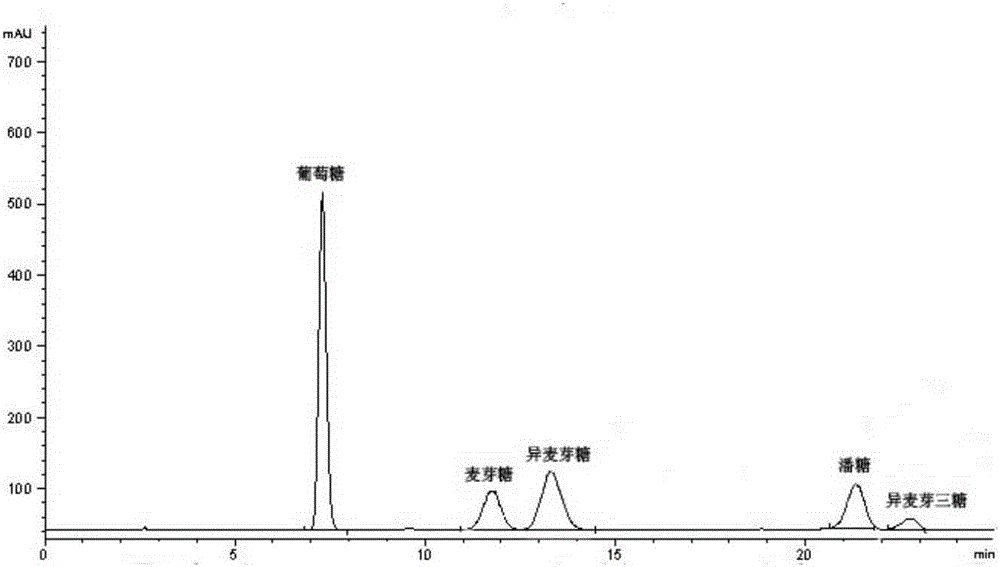Preparation method of isomalto-oligosaccharide and catalyst of isomalto-oligosaccharide
A technology of isomaltooligosaccharide and maltose syrup, which is applied in the manufacture of isomaltooligosaccharide and its catalyst field, can solve the problems of complex equipment and high operability, and achieve the effect of low enzyme loss, high catalytic activity and remarkable effect
- Summary
- Abstract
- Description
- Claims
- Application Information
AI Technical Summary
Problems solved by technology
Method used
Image
Examples
Embodiment 1
[0051] Embodiment 1: Obtaining of α-glucosidase coding gene fragment
[0052] The mRNA of Aspergillus niger (Aspergillus niger) CBS513.88 strain was extracted by liquid nitrogen grinding method, under the action of reverse transcriptase, RT-PCR was carried out with Oligo(dT) as primer, and cDNA was prepared by reverse transcription. With this cDNA as a template, according to the α-glucosidase-related genes published by NCBI—agA, agB, agC, agD, agE, agF gene sequence, the upstream and downstream primers AGA-1 (SEQ ID NO: 3) and AGA-2 ( SEQ ID NO: 4), AGB-1 (SEQ ID NO: 5) and AGB-2 (SEQ ID NO: 6), AGC-1 (SEQ ID NO: 7) and AGC-2 (SEQ ID NO: 8), AGD-1 (SEQ ID NO: 9) and AGD-2 (SEQ ID NO: 10), AGE-1 (SEQ ID NO: 11) and AGE-2 (SEQ ID NO: 12), AGF-1 (SEQ ID NO: 13) and AGF-2 (SEQ ID NO: 14), and by the method of PCR The gene fragments of agA of 1815bp, agB of 2892bp, agC of 2229bp, agD of 2958bp, agE of 1764bp and agF of 1968bp were amplified respectively.
Embodiment 2
[0053] Example 2: Construction of α-glucosidase single gene integrated expression vector
[0054] The gene fragment obtained in Example 1 was cloned into the SnaBI site of the pPIC9k plasmid to obtain recombinant plasmids pPIC9k-agA, pPIC9k-agB, pPIC9k-agC, pPIC9k-agD, pPIC9k-agE, and pPIC9k-agF.
Embodiment 3
[0055] Example 3: Construction of α-glucosidase double gene tandem integration expression vector
[0056] Using the recombinant plasmid in Example 2 as a template to design upstream and downstream universal primers AOX1 (SEQ ID NO: 15) and AOX2 (SEQ ID NO: 16), obtain the promoter sequence and terminator sequence derived from pPIC9k by PCR amplification. α-glucosidase-related gene fragments, AOX-agA, AOX-agB, AOX-agC, AOX-agD, AOX-agE, AOX-agF. And respectively cloned into the XbaI site of the corresponding plasmid in step 2 (the corresponding plasmid was digested by XbaI and pfu and other DNA polymerases were filled in, and the corresponding fragments were connected), to obtain the recombinant plasmid pPIC9k-agAB of tandem expression of α-glucosidase-related genes, pPIC9k-agAC, pPIC9k-agAD, pPIC9k-agAE, pPIC9k-agAF, pPIC9k-agBC, pPIC9k-agBD, pPIC9k-agBE, pPIC9k-agBF, pPIC9k-agCD, pPIC9k-agCE, pPIC9k-agCF, pPIC9k-agDE, pPIC9k- agDF, pPIC9k-agEF.
PUM
 Login to View More
Login to View More Abstract
Description
Claims
Application Information
 Login to View More
Login to View More - R&D
- Intellectual Property
- Life Sciences
- Materials
- Tech Scout
- Unparalleled Data Quality
- Higher Quality Content
- 60% Fewer Hallucinations
Browse by: Latest US Patents, China's latest patents, Technical Efficacy Thesaurus, Application Domain, Technology Topic, Popular Technical Reports.
© 2025 PatSnap. All rights reserved.Legal|Privacy policy|Modern Slavery Act Transparency Statement|Sitemap|About US| Contact US: help@patsnap.com



